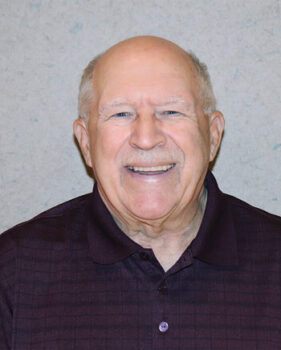
Bob Oswald, newest recipient of LLL’s Volunteer Spotlight
Oswald’s Technical Work Earns Volunteer Spotlight
Pamela O’Shea
Bob Oswald’s many technical contributions have earned him recognition as LifeLong Learning’s newest Volunteer Spotlight recipient.
Oswald and his wife, Betty, moved to PebbleCreek in 2007, after doing “a number of things in life before moving here.” He earned a bachelor’s degree in electrical engineering from Cleveland State University, along with additional coursework in structural engineering and business administration. Oswald worked as a consultant on high-voltage electrical projects, facilities, installations, and utilities throughout the U.S., Mexico, and Central America.
His career took him to many different places in the U.S. When considering retirement, the couple felt that PebbleCreek was the best place to live, with no snow and no hurricanes. You just have to shovel dirt and sand! Initially, they were attracted to PebbleCreek, because there is something for everyone here, whether it’s golf, pickleball, creative arts, or theater. Oswald served on the PC Pickleball Club’s board for three years, and still helps out on the courts. He has operated the theater’s soundboard during plays, lectures, and other events. PebbleCreek has many very talented people, and Oswald said he feels fortunate to be able to work with them.
His acquired knowledge of the sound system brought him to LifeLong Learning to help with its Monday Morning and Premier Lectures in Renaissance Theater.
“He has been immensely helpful during lectures and with videotaping and Zoom conferences,” said Pamela O’Shea, LLL’s director of volunteers. “He has been instrumental in ensuring that LLL’s programs are presented efficiently and professionally.”
Oswald commented that volunteer work can be challenging, but he loves working with many talented people. He said that volunteers support PebbleCreek’s activities and clubs and make the community attractive for all.
Developing Computers’ Creativity
Bill Nee
Computers can process data through neural networks, like our brains. Recent work by Microsoft, Google, and others have used computers to create art and poetry.
This month’s TED Talk, “How computers are learning to be creative,” by Blaise Aguera y Arcas, demonstrates how the process works to train neural networks to recognize images, run them in reverse, and create new works of art.
The results are spectacular, hallucinatory collages and poems that defy categorization. Aguera y Arcas shows how perception and creativity are intimately connected.
To view this new frontier in art and creativity, go to TED.com, click “watch” in the header, then “TED Talks,” then in “Search talks” input “How computers are learning to be creative,” scroll a little lower, and click on the talk you selected.
